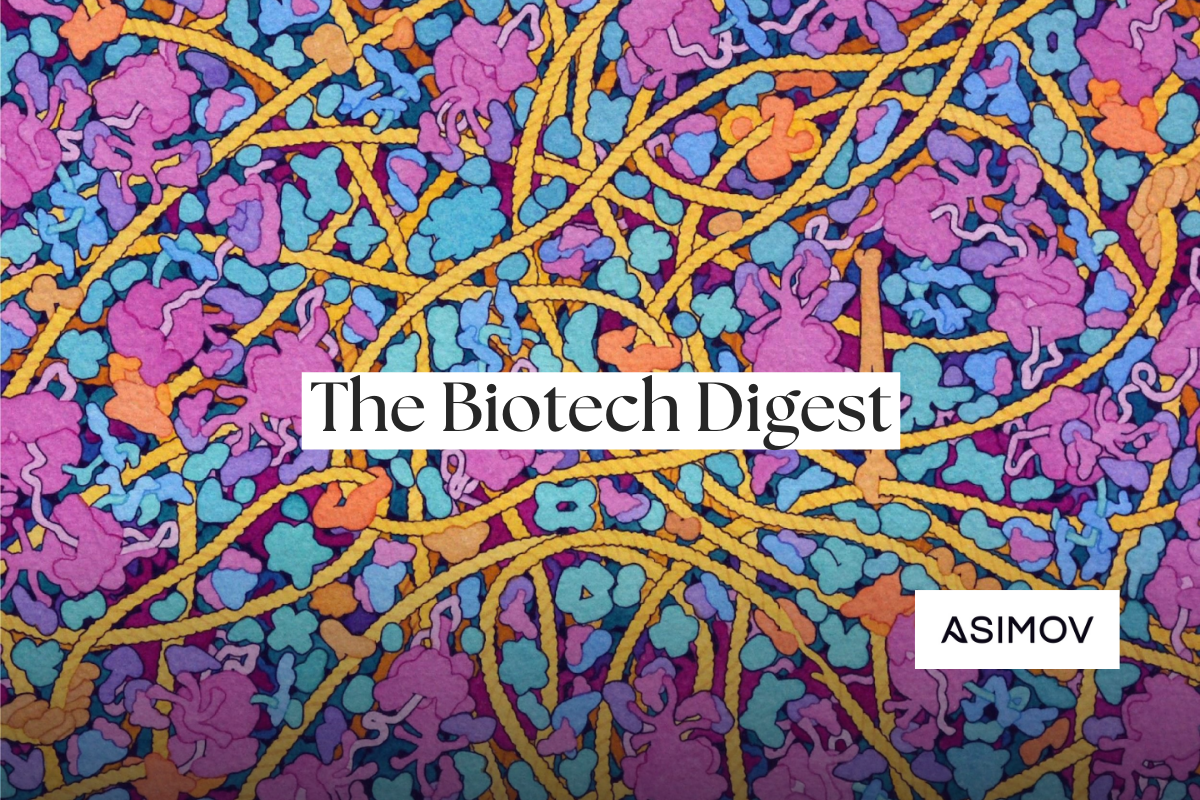The Biotech Digest No. 4
By Niko McCarty
This weekly digest highlights recent papers and news in biotechnology. Please send feedback to niko@asimov.com.
A Small Molecule for Sickle Cell Disease
More than 100,000 people in the U.S. have sickle cell disease, a genetic condition caused by mutations in the gene encoding hemoglobin, a protein that binds and carries oxygen throughout the body.
In December, the F.D.A. approved two new treatments for sickle cell disease, called Casgevy and Lyfgenia. Casgevy is a CRISPR-based therapy that treats the disease by deactivating a gene and coaxing blood cells to make a fetal form of hemoglobin. (Humans have two forms of hemoglobin protein, which are expressed at different stages of development.) People treated with Casgevy still carry the genetic mutation, but the adult hemoglobin becomes diluted by the healthy fetal form. Lyfgenia, on the other hand, uses a viral envelope packed with a healthy hemoglobin-producing gene to fix the problem directly in blood-making cells. Both of these therapies cost more than $2 million per patient.
A recent paper in Science, led by scientists at Novartis, reports a small molecule called dWIZ-2 that coaxes the body to make fetal hemoglobin. It is mechanistically similar to Casgevy, but without the gene-editing. The small molecule “induced [fetal hemoglobin] in humanized mice and cynomolgus monkeys,” according to the study. If dWIZ-2 works in humans, it would likely be a far cheaper option to treat people with sickle-cell disease.

Flow cytometry analysis of WIZ and HbF expression in moCD45−hCD45−CD71+ bone marrow cells after exposure to various doses of dWIZ-2.
The authors screened nearly 3,000 small molecules before finding a handful that induced fetal hemoglobin. Their screening approach was simple: Culture some blood cells that originally derived from human donors in the laboratory, and then expose them to different molecules for 13 days. Flow cytometry was used to separate out cells that highly expressed fetal hemoglobin after exposure to the molecules. A few “hits” emerged, one of which—called Compound C—was easily absorbed and didn’t seem to negatively impact how the cells behaved.
Subsequent experiments revealed that Compound C selectively targets a transcription factor called Wiz. It seems like the small molecule blocks Wiz from carrying out its normal function; namely, binding to promoters and enhancers in the genome to control fetal hemoglobin expression. Compound C was renamed dWIZ and, after optimization, dubbed dWIZ-2.
In cell culture, dWIZ-2 boosted the percentage of fetal hemoglobin-positive cells from a baseline of 17% to 45% in blood samples from sickle cell patients. In a humanized mouse model, dWIZ-2 increased the proportion of fetal hemoglobin-positive human erythroblasts in bone marrow from 10% to 42%. And in the cynomolgus monkeys, a 28-day treatment with dWIZ-2 (at a dose of 30 mg/kg) led to over 90% of immature red blood cells expressing fetal hemoglobin in two of three treated animals.
If this drug pans out in clinical trials, an oral medication for sickle cell disease would make treatments vastly more accessible to patients. More than half a million children are born with sickle cell disease every year, and the problem is especially acute in poor parts of the world, where gene therapies will remain prohibitively expensive for many years to come.
Temperature-Controlled Artificial Cells
It is pretty simple to make an “artificial” cell. First, actual cells are squished up and their cytoplasms extracted to make something called a cell-free system. Then, this cell-free liquid is enclosed in a lipid solution in oil to make droplets. And finally, those droplets are passed through an oil-water interface to add another layer to the outer membrane to form lipid-enclosed vesicles.
Over the years, scientists have “spruced up” cell-free mixtures to make artificial cells with intriguing properties. One can expose the vesicles to a chemical, for example, that turns genes on-or-off inside. I’ve even seen studies where scientists use small molecules to coax vesicles to grow and then divide.
One hypothetical application of artificial cells, though, is as a sort of medicine delivery vehicle for inside the human body. Artificial cells could be programmed to make medicines once they are located near a tumor. Or they could be programmed to sense dysfunction inside of the gut microbiome and then secrete small molecules to correct it. If artificial cells are only ever controlled with chemicals, though, then that really limits their utility because it’s hard to control where chemicals move through the body. It’s much easier to control heat.

(Left) Heating up an RNA thermometer encoding GFP leads to detectable fluorescence in less than 30 minutes. (Right) A schematic of the RNA thermometers.
For a study in Nature Chemical Biology, researchers have made heat-controlled artificial cells. Instead of controlling lipid vesicles with chemicals, they made “RNA thermometers” that were packaged into the artificial cells and, at room temperature, form a loop that prevents translation. When the RNA is heated up to 42°C, it straightens out, ribosomes can bind to it, and translation begins.
In the paper, the scientists from Imperial College London used a cell-free system and RNA thermometers to trigger artificial cells to secrete a protein. When the artificial cells were heated up, the ribosomes inside began translating the unfolded RNA molecules, which encoded a protein called alpha-hemolysin. This protein inserts into the lipid membrane and acts as a channel through which proteins and molecules can exit the cell. In one experiment, artificial cells that were heated up to 42°C exported four-times more fluorescent molecules than artificial cells at 30°C.
A lot of work needs to happen before these could be used clinically, of course. The artificial cells have some "leaky" protein production at lower temperatures, for example, which would need to be minimized. The stability, shelf-life, and manufacturing of these artificial cells at scale could also be improved.
 Fluorescent images of artificial cells containing RNA thermometers encoding GFP after incubation for 2 hours at 30 °C (left) or 42 °C (right).
Fluorescent images of artificial cells containing RNA thermometers encoding GFP after incubation for 2 hours at 30 °C (left) or 42 °C (right).
ezSingleCell
I just love tools that make science easier. Biotechnology has become such a broad field, requiring so much disparate expertise (Gene-editing! Single-cell omics! AI-based tools! Protein expression! A million other things!), that a lot of time is wasted just trying to get someone else’s code to work, or in figuring out which statistical methods to use on a dataset.
This study looks like a promising way to ease some of that burden, at least for single-cell data. A new paper in Nature Communications reports ezSingleCell, a web application to analyze single-cell and spatial omics data.
ezSingleCell includes many different analysis tools, and it can take in different kinds of single-cell data, including RNA sequencing, ATAC-seq, multi-omics, and spatial transcriptomics. The website has click-to-run analysis pipelines for clustering and differential gene expression, and for more advanced things such as cell type identification, batch correction, and spatial deconvolution. The tool processes about 50,000 cells in 5-6 minutes and 100,000 cells in 15 minutes.


Papers You Might Have Missed
(* = Recommended)
*Unsupervised evolution of protein and antibody complexes with a structure-informed language model. Science
*Highly multiplexed spatial transcriptomics in bacteria. bioRxiv
*An anti-CRISPR that pulls apart a CRISPR–Cas complex. Nature
*In vivo magnetogenetics for cell-type-specific targeting and modulation of brain circuits. Nature Nanotechnology
Evidence for widespread translation of 5′ untranslated regions. Nucleic Acids Research
Human plasma cells engineered to secrete bispecifics drive effective in vivo leukemia killing. Molecular Therapy
*ESM3 is a generative language model for proteins. bioRxiv
*Rockfish: A transformer-based model for accurate 5-methylcytosine prediction from nanopore sequencing. Nature Communications
Mammalian cell display with automated oligo design and library assembly allows for rapid residue level conformational epitope mapping. Communications Biology
*Functional protein mining with conformal guarantees. bioRxiv
The extent and characteristics of DNA transfer between plasmids and chromosomes. Current Biology
Structure and engineering of Brevibacillus laterosporus Cas9. Communications Biology
Targeting specific DNA G-quadruplexes with CRISPR-guided G-quadruplex-binding proteins and ligands. Nature Cell Biology
*Genome-wide quantification of RNA flow across subcellular compartments reveals determinants of the mammalian transcript life cycle. Molecular Cell
Spike deep mutational scanning helps predict success of SARS-CoV-2 clades. Nature
Tracking-seq reveals the heterogeneity of off-target effects in CRISPR–Cas9-mediated genome editing. Nature Biotechnology
A proximity proteomics pipeline with improved reproducibility and throughput. Molecular Systems Biology
High-throughput discovery of MHC class I- and II-restricted T cell epitopes using synthetic cellular circuits. Nature Biotechnology
*Energy-aware computational design of synthetic gene circuits. bioRxiv
*Geminivirus-based vectors for high cargo expression and gene targeting in plants. bioRxiv
De novo atomic protein structure modeling for cryoEM density maps using 3D transformer and HMM. Nature Communications
A new way to do multiplexed protein biosensing. JACS
Predicting protein flexibility with deep learning. Nature Communications
Spatial transcriptomes for fibrosis. Nature Genetics
A DNA robot that displays cytotoxic ligand nanopatterns. Nature Nanotechnology
Time of sample collection matters for microbiome analyses. Nature Metabolism
Targeting senescence induced by age or chemotherapy with a polyphenol-rich natural extract improves longevity and healthspan in mice. Nature Aging
Cryptic enzymatic assembly of peptides armed with β-lactone warheads. Nature Chemical Biology
Predicting glycan structure from tandem mass spectrometry via deep learning. Nature Methods
Cas12a domain flexibility guides R-loop formation and forces RuvC resetting. Molecular Cell
In Other News…
*Study links Ozempic to higher risk of eye condition that can cause vision loss. STAT
U.S. government will pay Moderna $176M to make an mRNA vaccine for H5N1. Ars Technica
June’s best science images. Nature
*Is mimicking the cells that carry hemoglobin the key to a blood substitute? Science
Formation Bio raises $372M for AI-driven drug development. Tech Crunch
Borderlands 3, the Bethesda video game, has a minigame that helped scientists solve the multiple sequence alignment problem. The Scientist
Chevron, Fishing Boats, and the FDA. Derek Lowe
Cassava Sciences collaborator charged with defrauding NIH in grants supporting its Alzheimer’s drug. STAT
Combined COVID-flu vaccines are coming: Moderna jab clears major test. Nature
- Moderna has completed phase III trials completed; the company says “the vaccine was more effective at providing immunity to adults over the age of 50 than competing flu and COVID-19 shots”
The Rubik’s Cube Turns 50. The New York Times
The best new science fiction books of July 2024. New Scientist (Keanu Reeves wrote a book.)


